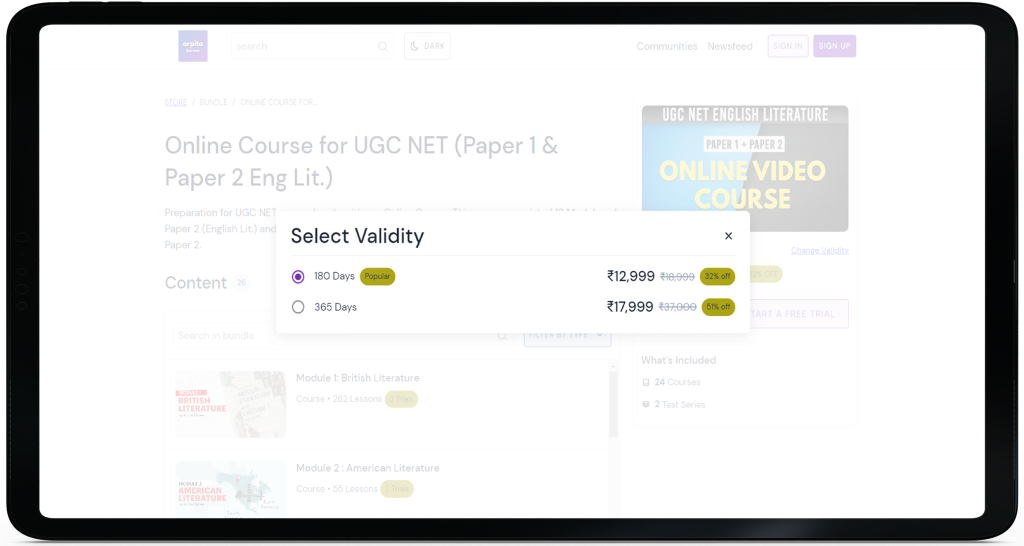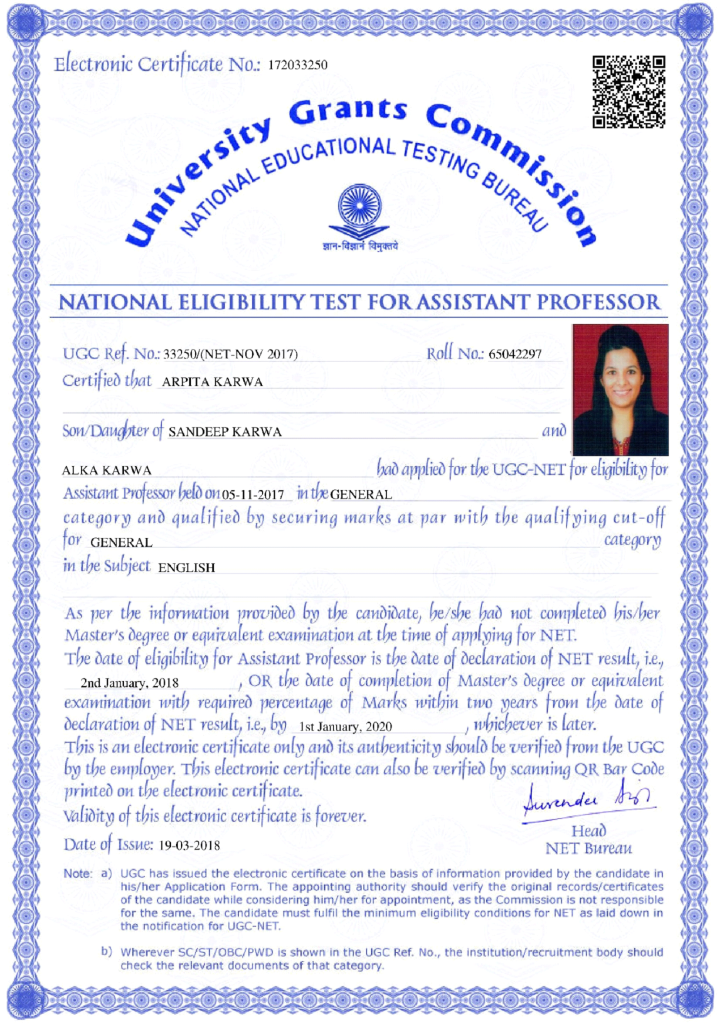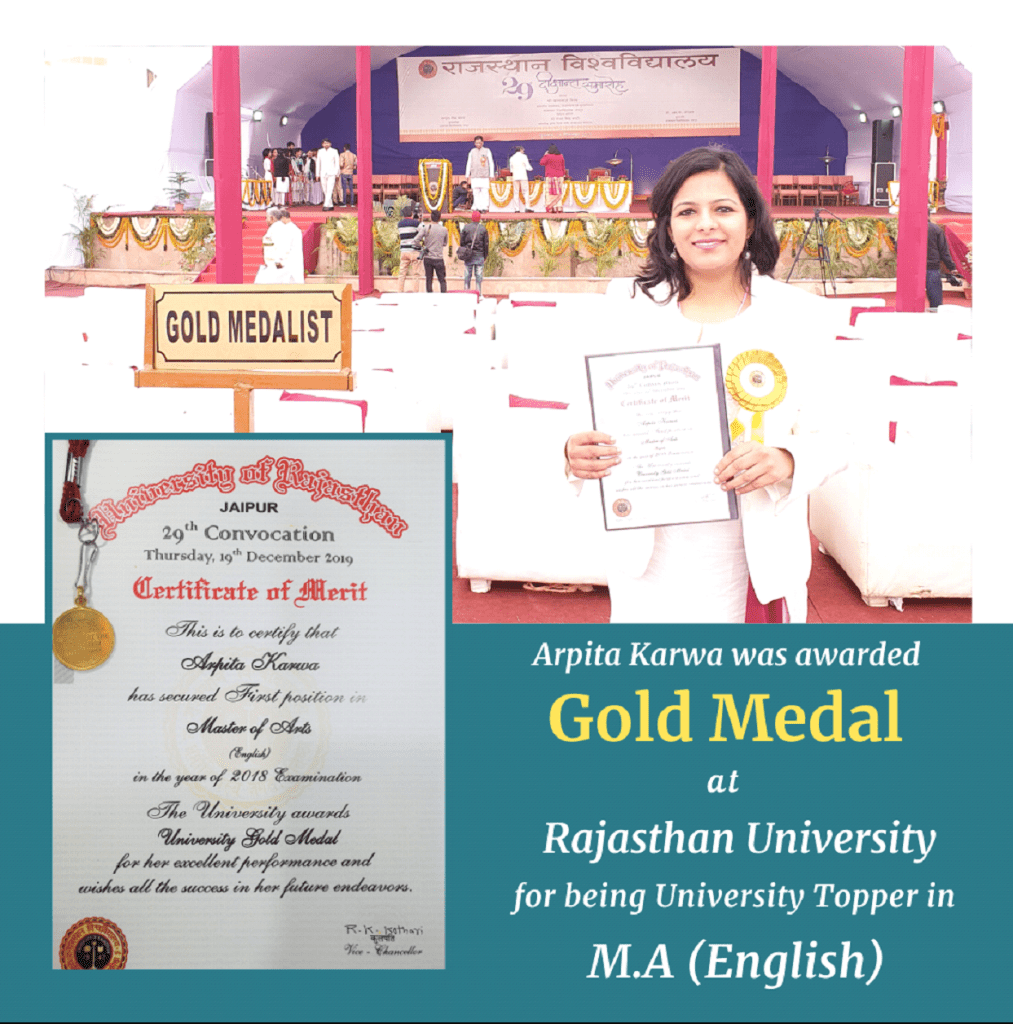June 2015 : Paper 3
October 19, 2022 2025-10-13 13:04June 2015 : Paper 3
June 2015 : Paper 3
Q.1) When Luigi Pirandello’s Six Characters in Search of an Author opens the audience find the producer attempting to stage a play. What is the title of this play ?
[1] “Rites of Performance”
[2] “Rules of the Game”
[3] “Tonight We Stage a Play”
[4] “Modes of Acting”
Answer: 2
Q.2) Which Canterbury pilgrim carries a brooch inscribed with the Latin words meaning “Love Conquers All” ?
[1] The Prioress
[2] The Monk
[3] The Wife of Bath
[4] The Squire
Answer: 1
Q.3) In his Introduction to The Oxford Book of Twentieth-Century English Verse (1973), Philip Larkin underlines the importance of a native tradition with seen as the major poet of the Modern Period.
[1] William Butler Yeats
[2] T.S. Eliot
[3] Thomas Hardy
[4] D.H. Lawrence
Answer: 3
Q.4) Philip Sidney defended poetry against such descriptions of it as “the mother of lies” and “the nurse of abuse.” His main argument here is .
[1] The poet is no conjuror or illusionist and represents a world.
[2] The poet cannot lie because he is not claiming to tell us the truth.
[3] The poet cannot speak the truth because he is not representing the real world.
[4] The poet is a philosopher for whom truth is a lie, and lie truth, in an imaginary world.
Answer: 2
Q.5) Chapter III of Oliver Twist opens with a narratorial remark about Oliver being punished for “the commission of the impious and profane offence of asking for more.” What did Oliver ask for more ?
[1] More time to play
[2] More food to eat
[3] More books to read
[4] More money to spend
Answer: 2
Q.6) Edmund Spenser’s Epithalamion is a carefully structured poem carrying __________ corresponding to the .
[1] twelve stanzas; months of the year
[2] three hundred and sixty five lines; days of the year
[3] fourteen stanzas; two week-long bridal ceremonies
[4] eleven stanzas; eleventh month, November
Answer: 2
Q.7) Choose the right chronological sequence below :
[1] Victorian Period – Jacobean Period – Tudor Period – Restoration Period
[2] Edwardian Period – Tudor Period – Jacobean Period – Victorian Period
[3] Tudor Period – Jacobean Period – Restoration Period – Edwardian Period
[4] Jacobean Period – Tudor Period – Restoration Period – Edwardian Period
Answer: 3
Q.8) “That woman’s days were spent In ignorant good – will, Her nights in argument Until her voice grew shrill” (W. B. Yeats : “Easter 1916”) Who is the poet referring to ?
[1] Maud Gonne
[2] Lady Augusta Gregory
[3] Kathleen Pilcher
[4] Constance Gore – Booth Markievicz
Answer: 4
Q.9) Which of the following was replaced by Communicative Language Teaching ?
[1] Motivational Approach
[2] Situational Language Teaching
[3] Natural Language Processing
[4] Structural Approach
Answer: 4
Q.10) To whom does Francis Bacon offer the following piece of advice ?
“Let him sequester himself from the Company of his Countrymen, and diet in such Places, where there is good company of the Nation… Let him upon his Removes, … procure Recommendation, to some person of Quality, residing in the Place, whither he removeth…”
[1] The Beaux
[2] The Peddler
[3] The Traveller
[4] The Stationer
Answer: 3
Q.11) In his masterpiece, Of the Lawes of Ecclesiasticall Politie, Richard Hooker affirmed the Anglican tradition as that of a “threefold cord not quickly broken.” He specifically referred to the following EXCEPT
[1] tradition
[2] scripture
[3] community
[4] reason
Answer: 3
Q.12) Match the following :
List – I
(a) Christina Rossetti : Goblin Market
(b) Matthew Arnold : Sohrab and Rustom
(c) Robert Browning : The Ring and the Book
(d) Arthur Hugh Clough : The Bothie of Tober-na-Vuolich
List – II
(i) The tale of a father who inadvertently destroys his son
(ii) Gently satiric account of an Oxford student on vacation
(iii) Story of pleasure-seeking Laura and the conventionally moral Lizzie who resists temptations
(iv) A sensational 17th century murder presented through multiple dramatic monologues
The right matching according to the code is :
[1] (a)-(iii), (b)-(iv), (c)-(i), (d)-(ii)
[2] (a)-(ii), (b)-(iv), (c)-(iii), (d)-(i)
[3] (a)-(iii), (b)-(i), (c)-(iv), (d)-(ii)
[4] (a)-(iv), (b)-(ii), (c)-(iii), (d)-(i)
Answer: 3
Q.13) “Beneath them sit the aged men, wise guardians of the poor; Then cherish pity, lest you drive an angel from your door.” These concluding lines of William Blake’s Innocence poem called “Holy Thursday” allude to a Biblical passage. Identify the passage.
[1] The angel of the Lord encampeth round about those who fear Him and delivereth them. Psalms 34.7
[2] Suffer not thy mouth to cause thy flesh to sin; neither say thou before the angel, that it was an error. Ecclesiastes 5.6
[3] And they said unto her, Thou art mad. But she constantly affirmed that it was even so.
Then said they, It is his angel. The Acts 12.15
[4] Be not forgetful to entertain strangers for thereby some have entertained angels unawares. Hebrews 13.2
Answer: 4
Q.14) Direct Method of Language Teaching involves :
a. the use of Target Language only
b. repetition of exercises
c. linguistic correctness
d. problem solving exercises
In relation to the above which of the following is correct ?
[1] (c) and (d) only
[2] (a), (b) and (d)
[3] (a), (b) and (c)
[4] (a), (b), (c) and (d)
Answer: 3
Q.15) In which of the following works does the narrator proclaim, “either I’m nobody, or I’m the nation” ?
[1] George Lamming’s In the Castle of My Skin
[2] Derek Walcott’s “The Schooner Flight”
[3] Jamaica Kincaid’s “Girl”
[4] Kamau Braithwaite’s “Nation Language”
Answer: 2
Q.16) Like Cordelia, the Fool in King Lear is .
[1] killed by Goneril’s troops.
[2] referred to by Lear as his child.
[3] disliked by Regan and Cornwall.
[4] punished for not telling the truth.
Answer: 2
Q.17) Sindi Oberoi, the narrator hero in Arun Joshi’s The Foreigner says : “My foreignness lay within me and I couldn’t leave myself behind wherever I went.” Identify the countries which Sindi Oberoi went to.
[1] Kenya, Uganda, England, America, India
[2] Kenya, Uganda, New Zealand, England, India
[3] Kenya, England, Canada, India
[4] Kenya, America, England, Australia, India
Answer: 1
Q.18) Assertion (A) : The world does not become raceless or will not become unracialized by assertion. The act of enforcing racelessness in literary discourse is itself a racial act.
Reason (R) : Pouring rhetorical acid on the fingers of a black hand may indeed destroy the prints, but not the hand. Besides, what happens, in that violent, self- serving act of erasure, to the hands, the fingers, the fingerprints of the one who does the pouring ? Do they remain acid-free ? The literature itself suggests otherwise.
In the context of the statements above,
[1] (A) makes complete sense in the light of (R).
[2] (A) makes complete sense regardless of (R).
[3] Neither (A) nor (R) makes complete sense.
[4] (R) challenges the view advanced in (A).
Answer: 1
Q.19) A poet laureate said “I do not think that since Shakespeare there has been such a master of the English language as I.” Who is the poet ?
[1] Stephen Spender
[2] John Dryden
[3] Alfred Lord Tennyson
[4] Ted Hughes
Answer: 3
Q.20) Who among the following was a contemporary of John Milton and wrote The Worthy Communicant ? It is said that his prose “can be read easily, when Milton’s must be studied.”
[1] Jeremy Taylor
[2] John Bunyan
[3] Andrew Marvell
[4] George Herbert
Answer: 1
Q.21) In 1668, Dryden wrote Of Dramatic Poesie : An Essay which uses__________ separate characters to dramatise the conflicting viewpoints which new theatrical activity had produced.
[1] three
[2] two
[3] four
[4] six
Answer: 3
Q.22) Writing his most influential play, August Strindberg called it “My most beloved drama, the child of my greatest suffering.” The play is :
[1] A Dream Play
[2] Miss Julie
[3] The Bridal Crown
[4] The Dance of Death
Answer: 1
Q.23) In which essay does Virginia Woolf observe that “if a writer were a free man [sic] and not a slave to the conventions of the literary market-place, there would be “no plot, no comedy, no tragedy, no love interest, or catastrophe in the accepted style, and perhaps not a single button sewn on as the Bond Street tailors would have it” ?
[1]”How it Strikes a Contemporary”
[2] “Modern Fiction”
[3] “The Russian Point of View”
[4] “Mr. Bennett and Mr. Brown”
Answer: 2
Q.24) In his famous letter to Benjamin Bailey (November 22, 1817) John Keats wrote : “I am certain of nothing but the holiness of the Heart’s affections and the truth of Imagination – What the imagination seizes as Beauty must be truth.” Which of the following sentences follows this passage ?
[1] Now I am sensible all this is a mere sophistication, however it may neighbour to any truths, to excuse my own indolence…
[2] The Imagination may be compared to Adam’s dream – he woke and found it true.
[3] This however I am persuaded of, that nothing beside Imagination can give us sweet sensations and pleasurable thoughts.
[4] My pains at last some respite shall afford, while I behold the battles Imagination maintains.
Answer: 2
Q.25) Which of the following pair best describes the characteristic features of Marlowe’s portrait of Tamburlaine ?
(a) ambition
(b) apathy
(c) cruelty
(d) sympathy
The right combination according to the code is .
[1] (a) and (b)
[2] (a) and (d)
[3] (a) and (c)
[4] (b) and (c)
Answer: 3
Q.26) Who is the author of the statement : “The nineteenth century dislike of Realism is the rage of Caliban seeing his own face in the glass” ?
[1] Arthur Symons
[2] Benjamin Disraeli
[3] W. B. Yeats
[4] Oscar Wilde
Answer: 4
Q.27) Which of the following statements about Thomas Mann’s novels is true ?
a. Buddenbrooks is a family saga set in the early decades of the twentieth century.
b. Aschenbach, the writer protagonist in Death in Venice, is preoccupied with classicism, especially with classical ideals of male beauty.
c. In his second winter at the sanatorium, Hans Castorp, protagonist of The Magic Mountain
gets lost in a blizzard during a solitary skiing expedition.
d. Adrian Leverkuhn, the modern day Faustus in Mann’s Doctor Faustus is a musician. The right combination according to the code is :
[1] Only (a) and (c) are correct
[2] Only (b) and (d) are correct
[3] (b), (c) and (d) are correct
[4] (a), (b) and (d) are correct
Answer: 3
Q.28) To whom did Raja Ram Mohan Roy write in 1823 his letter seeking the introduction of English education in India ?
[1] Lord Amherst
[2] Lord Bentinck
[3] Lord Cunningham
[4] Lord Hastings
Answer: 1
Q.29) Listed below are the seemingly friendly characters in The Pilgrim’s Progress who give Christian dangerous advice. Among them is one who does not belong to this group. Identify this odd character.
[1] Mr. Worldly Wiseman
[2] Evangelist
[3] Ignorance
[4] Talkative
Answer: 2
Q.31) The direct French influence on the English language during the Middle English period was in the form of .
[1] loss of inflections.
[2] intake of French words into English.
[3] both the loss of inflections and intake of French words into English.
[4] addition of inflections.
Answer: 2
Q.32) A significant development in 1662 was the establishment of The Royal Society in England. The main purpose of the society was
[1] to set the rules for the royal court and governance
[2] to guide and promote the development of science and scientific exploration
[3] to set norms for civil society
[4] to promote theatre
Answer: 2
Q.33) William Cowper wrote in The Task (IV. 681-82) about those who “Build factories with blood, conducting trade/At the sword’s point …” These lines allude to :
[1] Turkish militant traders across Europe
[2] Nordic conquerors across East Asia
[3] West Indian slave-plantation owners and the East India Company ‘nabobs’
[4] Exploiters of child labour in the London suburbs
Answer: 3
Q.34) The commedia dell’arte originated in Italy in the sixteenth century. Which of the following descriptions are the most appropriate ?
a. Tears alternating with crude laughter
b. Comedy of the guild or by the professionals in the “art”
c. Plautine comedy alternating with ritualistic manoeuvres
d. Improvised comedy that follows a scenario rather than written dialogue The right combination according to the code is :
[1] (a) and (b)
[2] (b) and (d)
[3] (a) and (c)
[4] (b) and (c)
Answer: 2
Q.35) “Nature and Nature’s Laws lay hid in Night, God said Let Newton be! And all was Light.”
Alexander Pope’s famous couplet impressively captures:
[1] Newton’s confirmation of the Genesis passage where God ordains Light
[2] Newton’s empirical observations of Philosophiae Naturalis Principia Mathematica
[3] Newton’s application of principles of motion to account for many natural phenomena
[4] Newton’s discovery that all colours are contained in white light
Answer: 4
Q.36) What was the name of the experimental theatre group founded in 1915 by Susan Glaspell, Eugene O’Neill and other dramatists in order to challenge Broadway’s control over American drama ?
[1] The Wall Street Theatre Group
[2] The Washington Square Players
[3] The Actor’s Studio
[4] The Provincetown Players
Answer: 4
Q.37) After his return from the land of Houyhnhnms, Gulliver refused to let his wife and children __________ .
[1] show disrespect to English horses.
[2] ride horse-drawn carriages.
[3] touch his bread, or drink out of his cup.
[4] communicate with him in English tongue.
Answer: 3
Q.38) In which of the following volumes do you find a charming appreciation of the Wordsworth household by Thomas de Quincey ?
[1] The Confessions of an English Opium-Eater
[2] Lives and Letters, Far Away and Long Ago
[3] Notes on My Lake Country Evenings
[4] Reminiscences of the English Lake Poets
Answer: 4
Q.39) One of the most highly revered, scholarly, and passionate interpreters of English and world literatures, he was appointed the Lord Northcliffe Professor of Modern English Literature at University College, London in 1967, and later as King Edward VII Professor of English Literature at Cambridge in 1974, an appointment made by the Crown at the suggestion of the Prime Minister of the United Kingdom. He was knighted by Queen Elizabeth in 1991. Entitled to designate himself as “Sir,” he never did, but wrote and autobiography entitled Not Entitled in 1995. The epigraph to this book came from Coriolanus : “He was a kind of nothing, titleless.”
Who among the following is this writer/critic ?
[1] F. R. Leavis
[2] I. A. Richards
[3] Frank Kermode
[4] David Lodge
Answer: 3
Q.40) Which of the following provided theoretical basis for Audio-Lingual Method of Language Teaching ?
[1] Transformational Generative Linguistics
[2] Cognitive Psychology and Structural Linguistics
[3] Behaviourist Psychology and Bloomfieldian Structural Linguistics
[4] Systemic Functional Linguistics
Answer: 3
Q.41) Who among the following characters of The Cherry Orchard by Anton Chekhov dies in the final scene ?
[1] Anya
[2] Firs
[3] Varya
[4] Lopakhin
Answer: 2
Q.42) In tracing the history of English poetry, Thomas Gray’s “Progress of Poesy” invokes a major poet as follows :
“Nor second He, that rode sublime Upon the seraph-wings of Extasy, The secrets of th’ Abyss to spy.” Who is “He” ?
[1] William Shakespeare
[2] Edmund Spenser
[3] John Milton
[4] John Dryden
Answer: 3
Q.43) “I suffered from impaired eye-sight, depression and poverty and left Oxford without a degree. After a period as a teacher and my marriage to a widow twice my age, I left for London, to begin writing for a magazine, I produced my own journal.” Choose the correct answer, identifying the writer, the magazine and the journal.
[1] John Milton, The Examiner’s Magazine, London Magazine
[2] Joseph Addison, The Freeholder, The Tatler
[3] Richard Steele, The Guardian, The Spectator
[4] Samuel Johnson, The Gentlemen’s Magazine, The Rambler
Answer: 4
Q.44) Which of the American novelists is associated with the series of five books about Natty Bumppo, an old hunter, also called Leatherstocking ?
[1] Stephen Crane
[2] James Fennimore Cooper
[3] Herman Melville
[4] Jack London
Answer: 2
Q.45) In John Dryden’s Essay on Dramatic Poesy, Neander defends the English invention of __________.
[1] romantic comedy
[2] action tragedy
[3] tragi-comedy
[4] morality plays
Answer: 3
Q.46) Who wrote The History of Australian Literature in 1961 ?
[1] Randolph Stow
[2] H. M. Green
[3] Handel Richardson
[4] Francis Adam
Answer: 2
Q.47) Match the following :
Theorist
a. Bharata
b. Kuntaka
c. Bhamaha
d. Anandavardhana
Theories
(i) Vakrokti
(ii) Riti
(iii) Dhvani
(iv) Rasa
The right matching according to the code is :
[1] (a)-(i) (b)-(iv) (c)-(ii) (d)-(iii)
[2] (a)-(ii) (b)-(iii) (c)-(i) (d)-(iv)
[3] (a)-(iv) (b)-(i) (c)-(ii) (d)-(iii)
[4] (a)-(iii) (b)-(ii) (c)-(iv) (d)-(i)
Answer: 3
Q.48) What is “Forster Collection” ?
[1] Memorabilia and documents related to the Scottish War of Independence (1296-1328) housed in Glasgow Museum
[2] The special collection of E. M. Forster effects housed in King’s College, Cambridge
[3] The largest collection of Charles Dickens manuscripts and proofs curated by John Forster
[4] The collection of political and military documents named after the liberal M. P., W. E. Forster reputed for the Forster Education Act
Answer: 3
Q.49) What was remarkable about the poet F. T. Marinetti’s first Futurist Manifesto in Le Figaro ?
[1] It resounded like the monotonous beating of a big drum that filled the air with muffled shocks and lingering vibration.
[2] It proclaimed that someone must go on writing for those who were still convinced of the future for which they had taken up arms.
[3] It blasted the dead weight of “museums, libraries, and academics,” glorifying “the beauty of speed.”
[4] It declared that man, the individual, is an infinite reservoir of possibilities; and if man can so rearrange society by the destruction of oppressive disorder, then the possibilities have a future.
Answer: 3
Q.50) How would one best describe Thomas Carlyle’s Sartor Resartus (1833) ?
[1] A combination of journal, fashion-book, and tips for advertisers
[2] A lyrical novel a la Marcel Proust
[3] A combination of novel, autobiography, and essay
[4] A satire on sartorial fashions and feibles of medieval Europe
Answer: 3
Q.51) An Indian English poet once remarked that his discipline and education gave him his “outer” whereas his Indian origin gave him “inner” form. Reflecting a part of this claim is a famous essay he called .
[1]”Is There a Native Way of Thinking ?”
[2]”Can the Subaltern Speak ?”
[3]”Where Do We Go from Here : Some Speculations”
[4]”Is There an Indian Way of Thinking ?”
Answer: 4
God, Janie is called upon to speak. Whose voice do we hear in the narrative ?
[1] Tea Cake’s voice
[2] Janie’s first-person voice
[3] Pheoby’s voice
[4] The omniscient third-person voice
Answer: 4
Q.53) Who is the author of the statement “A prophet is a Seer, not an Arbitrary Dictator” ?
[1] Salman Rushdie
[2] Kahlil Gibran
[3] William Blake
[4] Oscar Wilde
Answer: 3
Q.54) The word order in Modern English became relatively fixed because .
[1] it developed its inflectional system.
[2] it lost its highly developed inflectional system.
[3] it lost its derivational system of word formation.
[4] it developed its derivational system of word formation
Answer: 2
Q.55) Julia Kristeva’s ‘intertextuality’ derives from .
a. Noam Chomsky’s Deep Structure
b. Mikhail Bakhtin’s Dialogism
c. Jacques Derrida’s Difference
d. Ferdinand de Saussure’s Sign
The right combination according to the code is :
[1] (a) and (b)
[2] (b) and (c)
[3] (c) and (d)
[4] (b) and (d)
Answer: 4
Q.56) Dylan Thomas’s famous poem “Fern Hill,” is named after .
[1] a countryside in Austria to which he paid occasional visits.
[2] a childhood haunt of the poet’s family in Devonshire.
[3] the Welsh farmhouse where the poet spent summer holidays as a boy
[4] The Welsh Anglican church to which the young poet used to be taken by his mother.
Answer: 3
Q.57) “In the seventeenth century,” writes T. S. Eliot in “The Metaphysical Poets,” “a dissociation of sensibility set in, from which we have never recovered; and this dissociation, as is natural, was aggravated by the influence of the two most powerful poets of the century, and __________ .
[1] Ben Jonson and Abraham Cowley
[2] George Herbert and Henry Vaughan
[3] John Donne and Andrew Marvell
[4] John Milton and John Dryden
Answer: 4
Q.58) The label ‘material feminism’ refers to the work of those thinkers who study inequality in terms of .
[1] gender differences.
[2] class differences.
[3] both gender and class differences.
[4] female consumerism.
Answer: 3
Q.59) Who among the following displays in her best work the dual influence of feminism and magic realism ?
[1] Pat Barker
[2] Muriel Spark
[3] Angela Carter
[4] J. K Rowling
Answer: 3
Q.60) Identify the group of British poets who evidently draw upon new trends in literary theory (such as poststructuralism) and wrote poems that reflect on themselves and the language used in/by them.
[1] Seamus Heaney, Michael Longley, Derek Mahon
[2] Medbh McGuckian, Denise Riley, Wendy Cope
[3] Christopher Middleton, Roy Fisher, J. H. Prynne
[4] Donald Davie, Charles Tomlinson, Thom Gunn
Answer: 3
Q.61) In Old English other grammatical classes also had the four cases that nouns had. Which were these grammatical classes ?
[1] Pronouns and verbs only
[2] Pronouns and adjectives only
[3] Definite article and verbs only
[4] Pronouns, adjectives and definite article
Answer: 4
Q.62) Which of the following novels opens with the description of an accident to a hot-air balloon ?
[1] John Fowles’s The Magus
[2] Ian McEwan’s Enduring Love
[3] James Kelman’s How Late It Was, How Late
[4] Irvine Welsh’s Trainspotting
Answer: 2
Q.63) Azizun, a courtesan from Kanpur in A Tale from the Year 1857 : Azizun Nisa by Tripurari Sharma undergoing self-actualisation says : “Yes, I must complete what I’ve set out to do. I’m not a mere woman.” In order to make her impact by her attitudinal shift, she .
[1] challenges the codifiers of the Shariat.
[2] forsakes her profession to become a soldier.
[3] becomes a political leader.
[4] becomes a successful dancer.
Answer: 2
Q.64) The hermeneutics of suspicion is a term coined by Paul Ricoeur .
a. to designate the postcolonial tendency to see theory and related reading manoeuvres as a global conspiracy.
b. to describe interpretive bids that challenge and seek to overcome compartmentalized cultural experiences.
c. who, following Marx, Nietzsche, and Freud, held that textual appearances are deceptive and texts do not gracefully relinquish their meanings.
d. to describe a mode of interpretation that adopts a distrustful attitude towards texts in order to elicit otherwise inaccessible meanings or implications.
The right combination according to the code is :
[1] (a) and (b)
[2] (a) and (d)
[3] (c) and (d)
[4] (b) and (c)
Answer: 3
Q.65) Which of the following is not a feminist novel ?
[1] Ashapurna Debi’s Subarnalata
[2] Rajam Krishnan’s Lamp in the Whirlpool
[3] Chudamani Raghavan’s Yamini
[4] Bani Basu’s The Enemy Within
Answer: 4
Q.66) The term ‘poetic justice’ was coined by .
[1] Samuel Taylor Coleridge
[2] Thomas Rymer
[3] Samuel Johnson
[4] William Wordsworth
Answer: 2
Q.67) Which of the following novels deals with the Biafran War ?
[1] July’s People
[2] Waiting for the Barbarians
[3] Half of a Yellow Sun
[4] Arrow of God
Answer: 3
Q.68) Which of the following is not true in Dalit aesthetics as given by Sharan Kumar Limbale ?
[1] The agony, assertion, resistance, anger and protest of the dalits should be expressed.
[2] Dalit anubhava (experience) should take precedence over anuman (speculation).
[3] Sympathy for the dalits should be generated.
[4] Ungrammatical language, different from the standard norms of expression, should be used.
Answer: 3
Q.69) Which of the following is not a critical study by William Empson ?
[1] Seven Types of Ambiguity
[2] The Dyer’s Hand
[3] Milton’s God
[4] Some Versions of the Pastoral
Answer: 2
Q.70) This was a path-breaking feminist essay written in the 1970s which used hybrid terms like “sext” and “chaosmos.” Identify the author.
[1] Luce Irigaray
[2] Helene Cixous
[3] Julia Kristeva
[4] Simon de Beauvoir
Answer: 2
Q.71-75) Read the poem and answer the questions that follow (71 – 75) :
The Voice Woman much missed, how you call to me, call to me, Saying that now you are not as what you were
When you had changed from the one who was all to me But as first, when our day was fair
Can it be you that I hear ? Let me view you, then Standing as when I drew near to the town
Where you would wait for me : yes, as I knew you then, Even to the original air-blue gown!
Or is it only the breeze, in its listlessness Travelling across the wet mead to me here, You being ever dissolved to wan wistlessness Heard no more again far or near ?
Thus I; faltering forward, Leaves around me falling,
Wind oozing thin through the thorn from norward And the woman calling.
Q.71) What suggestion does the opening stanza give of a woman won or a woman lost ?
[1] The contrast between ‘now’ and ‘then’
[2] The continuity between ‘now’ and ‘then’
[3] The phrase “had changed”
[4] The phrase “our day was fair”
Answer: 1
Q.72) What is tantalizing about the speaker’s experience in stanza 2 ?
[1] the disappearance of the lady and the echo of the voice
[2] the indistinct voice heard by the speaker and the absence of woman
[3] The uncertainty of the voice and the speaker’s inability to see the woman
[4] the woman disappearing before her voice is fully heard
Answer: 3
Q.73) What phrase in the poem suggests the possibility of the woman as “dead” ?
[1] “You had changed …. to me”
[2] “I knew you then”
[3] “You being ever dissolved”
[4] “Woman much missed”
Answer: 3
Q.74) Identify the special sound effect in the line given : Wind oozing thin through the thorn from norward…
[1] Alliteration
[2] Onomatopoeia
[3] Assonance
[4] The use of sibilants
Answer: 1
Q.75) What longing does the speaker voice ?
[1] longing for reunion in the other world
[2] longing for physical union in the present
[3] longing for physical union in the town where they used to meet
[4] longing for a return to the town where they used to meet
Answer: 3
























